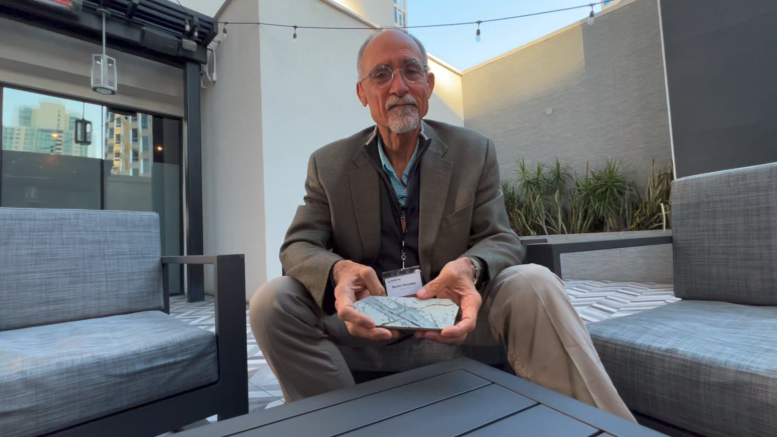While Majuba Hill Copper (CSE: JUBA; US-OTC: JUBAF) expects to release in the next three months an initial resource for its namesake property in Nevada, it anticipates releasing assays from three deep holes.
Underpinned by a non-compliant resource estimate, Buster Hunsaker, consulting geologist for Majuba Hill, says an initial development scenario for the project in Pershing County would look at a starter oxide scenario with an open pit. But the porphyry potential at depth gets the experienced geologist excited.
“The story is about what lies at depth – copper, silver, tin and gold,” says Hunsaker during a recent roadshow in San Diego, CA.
“An implication of finding tin and silver at depth is that we might be dealing with multiple mineralizing intrusives,” says the 40-year industry veteran.
Majuba Hill plans to release assay results from holes MHB-29, -28, and -27 in January, revealing deep drilling. “The deep stuff will reveal how it relates to a porphyry. Holes 27 and 28 didn’t go deep enough. [Hole] 29 – geologically, brings the picture together,” Hunsaker says.

Hole MHB-29 intersected sulphide mineralization occurring as long veins and disseminated throughout the core. Majuba Hill Copper.
Hole MHB-29 was drilled to 1,099 metres and represented the deepest mineralized hole. Initial observations of the core show sulphide mineralization occurs as long veins disseminated throughout. Hole MHB-29 intersected sulphide mineralization occurring as long veins and disseminated throughout the core. Majuba Hill Copper.
According to the geoscientist, Majuba Hill was historically known for its tin – not its copper. To date, his team has described four stages of mineralization it likens to being ‘stacked on a shelf.’
According to Hunsaker, working on this project was one of the best experiences of his career. “It’s to come across something so obvious, stuck out of the ground like a mountain of metal, and to recognize it, see the geology develop and be part of the first people to bring that out. It took effort for the first ten years to recognize the porphyry copper potential,” he says.
Where Majuba Hill sticks out in the western Nevada plains implies that it is located on an underexplored copper belt in a segment where there aren’t many mines, despite a significant volume of historical work on the geology. The brownfield site has produced 2.6 million lb. of copper on a historical basis.
The company believes that should it succeed in making a vital porphyry discovery, it could ideally play into the copper macro picture of a deficit of about 5 billion lb. of the red metal from about 2026 onwards.
“We stand on the shoulders of giants,” says Hunsaker. “There have been really good people who have worked on Majuba Hill over the years and built it out for us. The value of porphyry copper is unbelievable. When it gets into production, it will be one of those generational mines,” says Hunsaker.
Discovery potential
While the company bears down on some near-term catalysts, it has made important strides in recent months that point to significant porphyry potential.
On Sept. 20, Majuba Hill announced it had completed a conceptual (pre-inferred) global copper resource to use as an exploration guide.
On a copper-equivalent basis, the company says there are 491 million tons averaging 0.16% copper-equivalent, using a 0.06% cut-off. This comes to about 1.5 billion copper-equivalent pounds in the ground at an average grade of 0.18% copper-equivalent.
According to Hunsaker, that calculates to a notional gross metal value of US$5.1 billion. But because markets currently only attribute about US11¢ per lb. of copper held in compliant resources to enterprise value, Majuba Hill’s NAV should sit at around US$162 million, compared with the US$6.2 million as of Dec. 22.
More recently, Majuba Hill released results from the additional soil samples collected in 2022. It says the samples have significantly increased the size of the site’s DeSoto and Copper Gold targets. The company collected 1,050 samples to extend the previous sampling grid to the north, east, and west. The results also highlight the surface footprint for the 789 target.
“Copper, gold, silver, molybdenum, lead, and zinc have good zoning on the Majuba Hill project. The soil values indicate the very large size of the mineralizing copper porphyry system. Combining the 915 to 2,743-metre-wide anomalous zones and thick copper, silver, gold, moly, and zinc drill intercepts point to a mineral system typical of districts that host economic deposits,” Hunsaker says.

Drilling in 2021 extended the near-surface copper oxide and enrichment zones while also hitting high-level intrusives related to the underlying porphyry.
According to the geologist, future drilling will use these and the pending results to direct into the highest-grade parts of the target areas. Hunsaker is eager to undertake more prospecting and drilling at the exploration targets since initial indications are the company is tracing ‘smoke’ from several hidden porphyry feeders at depth, hidden by overburden.
The Majuba Hill property is 113 km southwest of Winnemucca and 251 km northeast of Reno. Access is by well-maintained county roads.
While Majuba Hill is a pre-resource play on the macro copper narrative, the pending deep-drilling results will reveal whether the company has a true copper porphyry discovery on its hands or not.
The company’s Canada-quoted stock is down more than 77% over the 12-month period at 20.5¢ a share.


Be the first to comment on "Video: Majuba Hill’s porphyry drilling gets interesting at depth"